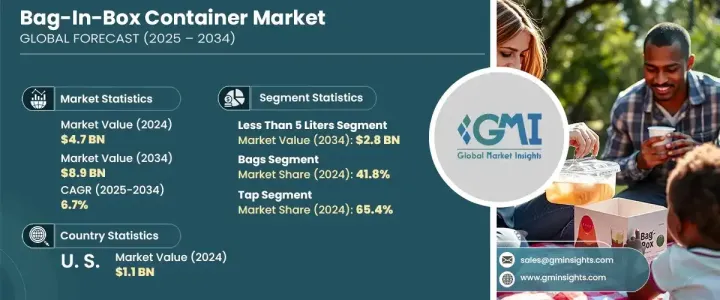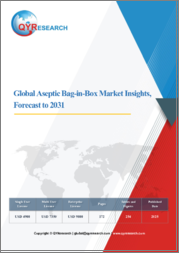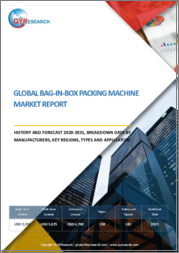
|
시장보고서
상품코드
1708121
세계의 백인박스(Bag in Box) 용기 시장 기회, 성장 촉진요인, 산업 동향 분석 및 예측(2025-2034년)Bag-In-Box Container Market Opportunity, Growth Drivers, Industry Trend Analysis, and Forecast 2025 - 2034 |
||||||
세계 백인박스 용기 시장은 2024년 47억 달러에 달했고, 2025-2034년 연평균 6.7%의 성장률을 보일 것으로 예측됩니다.
이 시장은 식음료, 산업용 액체, 생활용품 등 다양한 산업 분야 수요 증가로 인해 빠르게 성장하고 있습니다. 전 세계 기업들이 공급망 최적화와 비용 절감에 주력하고 있는 가운데, 백인박스 용기는 유연성, 내구성, 친환경적 특성으로 인해 획기적인 패키징 솔루션으로 부상하고 있습니다. 지속 가능하고 가벼운 포장 형태로의 전환이 진행됨에 따라, 제조업체들은 내용물을 보호할 뿐만 아니라 환경 친화적인 소비자들에게 어필할 수 있는 혁신적인 소재를 채택해야 할 필요성이 대두되고 있습니다. 인터넷 보급률 증가와 전자상거래의 붐으로 인해 포장 환경은 더욱 변화하고 있으며, 백인박스 용기와 같은 효율적이고 비용 효율적인 솔루션은 액체 제품을 안전하게 운송하는 데 필수적인 요소입니다.

이러한 추세는 특히 식음료 분야에서 두드러지게 나타나고 있으며, 작고 흘림이 적고 다루기 쉬운 포장에 대한 요구가 급증하고 있습니다. 탄소 배출량을 줄이고 제품 보존성을 향상시키고자 하는 기업들에게 백인박스 용기는 전 세계 제조업체와 소비자 모두에게 선호되는 선택이 되고 있습니다. 또한, 재활용 가능한 필름 및 고배리어 라미네이트와 같은 재료 기술의 발전은 다양한 응용 분야에서 이러한 용기의 채택을 가속화하고 있습니다. 또한, 플라스틱 폐기물 감소에 대한 인식이 높아지고, 백인박스(bag-in-box)와 같은 포장 형태가 기존의 경질 플라스틱 용기와 병을 대체할 수 있는 친환경적인 대안으로 간주되는 순환 경제 원칙으로의 전환도 시장 성장의 원동력으로 작용하고 있습니다.
| 시장 범위 | |
|---|---|
| 시작 연도 | 2024년 |
| 예측 연도 | 2025-2034년 |
| 시작 금액 | 47억 달러 |
| 예상 금액 | 89억 달러 |
| CAGR | 6.7% |
시장은 용기의 용량에 따라 5리터 미만에서 20리터 이상까지 다양한 크기로 구분됩니다. 그 중에서도 5리터 미만 용기는 강력한 성장이 예상되며, 2034년에는 28억 달러에 달할 것으로 예측됩니다. 작고 편리한 포장 솔루션에 대한 수요가 급증하는 것은 1회용 및 즉시 사용 가능한 제품에 대한 소비자의 선호도가 높아짐에 따른 것입니다. 이러한 소형 용기는 가볍고 재활용이 가능할 뿐만 아니라, 이동 중 소비 트렌드에 대응할 수 있습니다. 실용적인 디자인으로 조제 및 보관이 용이하여 음료, 조미료, 유제품 및 기타 액체 제품에 매우 적합합니다.
백-인-박스 용기 시장은 가방, 박스, 인서트 등 부품별로 세분화되며, 2024년에는 높은 차단성과 재활용이 가능한 소재의 혁신에 힘입어 가방 부문이 41.8%의 점유율을 차지했습니다. 제조업체들은 제품의 무결성을 유지하면서 환경 친화적인 포장에 대한 소비자 수요 증가에 대응하기 위해 연질 필름과 단일 소재의 라미네이트를 빠르게 채택하고 있습니다. 이러한 최신 소재는 제품의 보호와 보존성을 향상시키면서 전 세계의 지속가능성 노력에 부합하는 최신 소재입니다.
북미는 2024년 백인박스 용기 시장에서 25.7%의 점유율을 차지했으며, 이는 주로 친환경 포장 솔루션에 대한 선호도가 높아졌기 때문입니다. 이 지역 시장은 음료 산업에서 강력한 수요가 있으며, 음료 산업은 제품의 유통기한을 연장하고 환경에 미치는 영향을 줄이기 위해 백-인-박스 형식을 활용하고 있습니다. 기업과 소비자가 지속 가능한 포장을 우선시하는 가운데, 백인박스 용기는 실용적이고 환경 친화적인 대안으로 각 산업 분야에서 호응을 얻고 있습니다.
목차
제1장 조사 방법과 조사 범위
제2장 주요 요약
제3장 업계 인사이트
- 생태계 분석
- 업계에 대한 영향요인
- 성장 촉진요인
- 업계의 잠재적 리스크&과제
- 성장 가능성 분석
- 규제 상황
- 기술 동향
- 향후 시장 동향
- 갭 분석
- Porter's Five Forces 분석
- PESTEL 분석
제4장 경쟁 구도
- 서론
- 기업 점유율 분석
- 주요 시장 기업 - 경쟁 분석
- 경쟁 포지셔닝 매트릭스
- 전략 대시보드
제5장 시장 추산 및 예측 : 용량별, 2021년-2034년
- 주요 동향
- 5리터 미만
- 5-10리터
- 10-20리터
- 20리터 이상
제6장 시장 추산 및 예측 : 탭별, 2021년-2034년
- 주요 동향
- 탭 있음
- 탭 없음
제7장 시장 추산 및 예측 : 컴포넌트별, 2021년-2034년
- 주요 동향
- 백
- 박스
- Fitments
제8장 시장 추산 및 예측 : 용도별, 2021년-2034년
- 주요 동향
- 음료
- 주류
- 무알코올 음료
- 식품
- 우유 및 유제품
- 식용유
- 이유식
- 기타
- 화학제품 및 윤활유
- 가정용품
- 클리너
- 액체 세제
- 액체 비누 및 핸드솝
- 기타
제9장 시장 추산 및 예측 : 지역별, 2021년-2034년
- 주요 동향
- 북미
- 미국
- 캐나다
- 유럽
- 독일
- 영국
- 프랑스
- 스페인
- 이탈리아
- 네덜란드
- 아시아태평양
- 중국
- 인도
- 일본
- 호주
- 한국
- 라틴아메리카
- 브라질
- 멕시코
- 아르헨티나
- 중동 및 아프리카
- 사우디아라비아
- 남아프리카공화국
- 아랍에미리트(UAE)
제10장 기업 개요
- Amcor
- Aran Group
- BIBP
- CDF Corporation
- DS Smith
- Goglio
- Hangzhou Hansin New Packing Material
- International Paper
- Karl Knauer
- Mondi Group
- Montibox
- Optopack
- Sealed Air
- SIG
- Smurfit Kappa
- Westrock
- Zarcos America
The Global Bag-In-Box Container Market reached USD 4.7 billion in 2024 and is projected to expand at a CAGR of 6.7% between 2025 and 2034. The market is rapidly evolving, driven by growing demand across various industries including food, beverage, industrial liquids, and household products. As businesses worldwide focus on optimizing their supply chain and reducing costs, bag-in-box containers are emerging as a game-changing packaging solution due to their flexibility, durability, and eco-friendly attributes. The growing shift toward sustainable and lightweight packaging formats is pushing manufacturers to adopt innovative materials that not only protect the contents but also appeal to environmentally conscious consumers. Increasing internet penetration and the boom in e-commerce has further transformed the packaging landscape, making efficient and cost-effective solutions like bag-in-box containers essential for shipping liquid products safely.

This trend is especially visible in the food and beverage sectors, where the need for compact, spill-proof, and easy-to-handle packaging is rising sharply. With companies aiming to reduce carbon footprints and improve product shelf life, bag-in-box containers are becoming a preferred choice for both manufacturers and consumers worldwide. Additionally, advancements in material technology, including recyclable films and high-barrier laminates, are accelerating the adoption of these containers in diverse application areas. The market is also benefiting from increasing awareness about reducing plastic waste and the global shift towards circular economy principles, where packaging formats like bag-in-box are viewed as eco-friendly alternatives to traditional rigid plastic containers and bottles.
| Market Scope | |
|---|---|
| Start Year | 2024 |
| Forecast Year | 2025-2034 |
| Start Value | $4.7 Billion |
| Forecast Value | $8.9 Billion |
| CAGR | 6.7% |
The market is segmented based on container capacity, with sizes ranging from less than 5 liters to over 20 liters. Among these, the less than 5 liters segment is poised for robust growth, expected to reach USD 2.8 billion by 2034. The surge in demand for compact and convenient packaging solutions is fueled by rising consumer preferences for single-serve and ready-to-use products. These smaller containers are not only lightweight and recyclable but also cater to growing on-the-go consumption trends. Their practical design allows for easy dispensing and storage, making them highly suitable for beverages, condiments, dairy, and other liquid products, all while supporting sustainability goals through reduced material usage and carbon emissions.
The bag-in-box container market is further segmented by components, including bags, boxes, and fitments. In 2024, the bags segment commanded a 41.8% share, driven by innovations in high-barrier, recyclable materials. Manufacturers are rapidly adopting flexible films and mono-material laminates to meet rising consumer demand for eco-friendly packaging that maintains product integrity. These modern materials are enhancing product protection and shelf life while aligning with global sustainability efforts.
North America accounted for a 25.7% share of the bag-in-box container market in 2024, largely due to the growing emphasis on eco-friendly packaging solutions. The regional market is witnessing strong demand from the beverage industry, which is leveraging bag-in-box formats to extend product shelf life and reduce environmental impact. As businesses and consumers prioritize sustainable packaging, bag-in-box containers are gaining traction as a practical and green alternative across industries.
Table of Contents
Chapter 1 Methodology and Scope
- 1.1 Market scope and definitions
- 1.2 Research design
- 1.2.1 Research approach
- 1.2.2 Data collection methods
- 1.3 Base estimates and calculations
- 1.3.1 Base year calculation
- 1.3.2 Key trends for market estimation
- 1.4 Forecast model
- 1.5 Primary research and validation
- 1.5.1 Primary sources
- 1.5.2 Data mining sources
Chapter 2 Executive Summary
- 2.1 Industry 3600 synopsis
Chapter 3 Industry Insights
- 3.1 Industry ecosystem analysis
- 3.2 Industry impact forces
- 3.2.1 Growth drivers
- 3.2.1.1 Increasing demand in FMCG industry
- 3.2.1.2 Rising preference for packaged natural food products
- 3.2.1.3 Expansion in household products segment
- 3.2.1.4 Growth in e-commerce and home delivery services
- 3.2.1.5 Rising market inclination towards sustainable packaging solutions
- 3.2.2 Industry pitfalls and challenges
- 3.2.2.1 Limited applicability for carbonated beverages
- 3.2.2.2 Regulatory compliances
- 3.2.1 Growth drivers
- 3.3 Growth potential analysis
- 3.4 Regulatory landscape
- 3.5 Technology landscape
- 3.6 Future market trends
- 3.7 Gap analysis
- 3.8 Porter's analysis
- 3.9 PESTEL analysis
Chapter 4 Competitive Landscape, 2024
- 4.1 Introduction
- 4.2 Company market share analysis
- 4.3 Competitive analysis of major market players
- 4.4 Competitive positioning matrix
- 4.5 Strategy dashboard
Chapter 5 Market Estimates and Forecast, By Capacity, 2021 - 2034 (USD Bn & Kilo Tons)
- 5.1 Key trends
- 5.2 Less than 5 liters
- 5.3 5 to 10 liters
- 5.4 10 to 20 liters
- 5.5 Above 20 liters
Chapter 6 Market Estimates and Forecast, By Tap, 2021 - 2034 (USD Bn & Kilo Tons)
- 6.1 Key trends
- 6.2 With tap
- 6.3 Without tap
Chapter 7 Market Estimates and Forecast, By Component, 2021 - 2034 (USD Bn & Kilo Tons)
- 7.1 Key trends
- 7.2 Bags
- 7.3 Box
- 7.4 Fitments
Chapter 8 Market Estimates and Forecast, By Application, 2021 - 2034 (USD Bn & Kilo Tons)
- 8.1 Key trends
- 8.2 Beverages
- 8.2.1 Alcoholic beverages
- 8.2.2 Non-alcoholic beverages
- 8.3 Food
- 8.3.1 Milk and dairy products
- 8.3.2 Edible oils
- 8.3.3 Baby & toddler food
- 8.3.4 Others
- 8.4 Chemicals & lubricants
- 8.5 Household products
- 8.5.1 Cleaners
- 8.5.2 Liquid detergents
- 8.5.3 Liquid soaps & hand wash
- 8.6 Others
Chapter 9 Market Estimates and Forecast, By Region, 2021 - 2034 (USD Bn & Kilo Tons)
- 9.1 Key trends
- 9.2 North America
- 9.2.1 U.S.
- 9.2.2 Canada
- 9.3 Europe
- 9.3.1 Germany
- 9.3.2 UK
- 9.3.3 France
- 9.3.4 Spain
- 9.3.5 Italy
- 9.3.6 Netherlands
- 9.4 Asia Pacific
- 9.4.1 China
- 9.4.2 India
- 9.4.3 Japan
- 9.4.4 Australia
- 9.4.5 South Korea
- 9.5 Latin America
- 9.5.1 Brazil
- 9.5.2 Mexico
- 9.5.3 Argentina
- 9.6 Middle East and Africa
- 9.6.1 Saudi Arabia
- 9.6.2 South Africa
- 9.6.3 UAE
Chapter 10 Company Profiles
- 10.1 Amcor
- 10.2 Aran Group
- 10.3 BIBP
- 10.4 CDF Corporation
- 10.5 DS Smith
- 10.6 Goglio
- 10.7 Hangzhou Hansin New Packing Material
- 10.8 International Paper
- 10.9 Karl Knauer
- 10.10 Mondi Group
- 10.11 Montibox
- 10.12 Optopack
- 10.13 Sealed Air
- 10.14 SIG
- 10.15 Smurfit Kappa
- 10.16 Westrock
- 10.17 Zarcos America



















